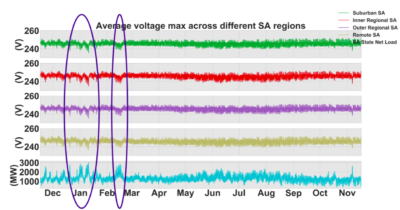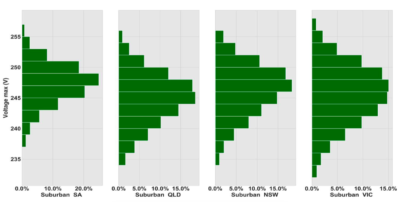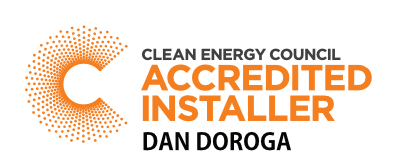

Recently UNSW released a study exposing the grid voltage rate in Australia which is affecting homes with solar systems and the results they found weren’t good.
You might be wondering what voltage is, simply put, it’s the force that moves electrical current through power lines to homes. So all that AC your inverter generates requires voltage in order for it to move around your home and also for it to move to the grid. The tricky thing is that voltage is never a constant variable and depending on the demand for power will depend on the voltage reading. A healthy voltage rating is between 216.2 to 235 volts, this allows for a +10% rise and a -6% decrease. The voltage on the grid is meant to be around about 230volts at all times. If the voltage is too low, the power supply in your house will be poor and may also cut out and if it’s too high, power will be wasted and power bills may increase.
Overvoltage is one of the most common issues that impact your panels’ performance, it happens when the grid voltage exceeds 258 volts and it when more solar is generated than power being used.
When the voltage gets to 253 volts it becomes too high for solar AC to reach the grid, this may result in lost feed-in tariff for your home. If your inverter is at 256volts during the day, then it will be limited to 68% of its total capacity.
There’s a lot of talk in the media and with power providers that solar destabilises the grid as your inverter increases voltage by 2 volts when it’s producing power. Now, this wouldn’t be an issue if the grid voltage was at a lower reading as it would be able to handle 2 volts extra. With more solar systems installed will increase the voltage on the Grid in order to support the power flow.
UNSW study findings

Over 12,000 homes were monitored during the UNSW study and 29.5% of tests conducted happened in South Australia.
UNSW researchers believe that the only way for this issue to truly be resolved is if the voltage on the grid gets increased.

Ways to improve overvoltage cutouts:
Your local distribution network service provider (DNSP) ours is SA Power Networks, legally have to fix the voltage if it’s higher than the standard range (mentioned above). You can make a claim to them and they will set up a voltage monitoring system in your area. It will take roughly around 3 months to complete the monitoring process and if the verdict comes back that the voltage is in fact too high then SA Power Networks will fix the issue. However, it may take up to 12 weeks to do so.
*all graph data shown comes from the UNSW study results and not from SA Regional Solar.


Enerco/Dan the Solar Man (formerly SA Regional Solar) has a solid team of industry professionals and technical staff.
We believe that our people are the most important asset and invest continuously in their development.
Our customers benefit from our knowledge and experience, enabling us to create win-win outcomes all around.
When you deal with Dan the Solar Man or Enerco Pty Ltd you'll be talking to an expert.